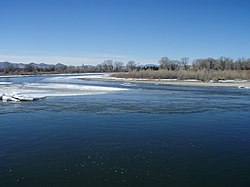Missouri River Headwaters State Park
|
Three Forks of the Missouri
|
|

Confluence of Madison and Jefferson
|
|
| Location | Gallatin County, Montana |
|---|---|
| Nearest city | Three Forks, Montana |
| Coordinates | 45°55′15″N 111°29′53″W / 45.9207°N 111.4980°WCoordinates: 45°55′15″N 111°29′53″W / 45.9207°N 111.4980°W |
| Area | 1,500 acres (610 ha) |
| Built | 1805 |
| NRHP reference # | 66000433 |
| Significant dates | |
| Added to NRHP | October 15, 1966 |
| Designated NHL | October 9, 1960 |
Missouri Headwaters State Park is a Montana state park that marks the official start of the Missouri River. It includes the Three Forks of the Missouri National Historic Landmark, designated in 1960 because the site is one where the Lewis and Clark Expedition camped in 1805. The park is open for day use and camping, offering hiking trails, hunting, and water-related activities. It is located on Trident Road northeast of Three Forks, Montana at an elevation of 4,045 feet (1,233 m).
The bulk of Missouri Headwaters State Park is found on a peninsula flanked on the east by the Gallatin River and the west by the Missouri River and the Madison River. Small parts of the park are also located on the east bank of the Gallatin River, and an island in the Missouri just below the confluence of the Madison and Jefferson Rivers. The total park size is 532 acres (215 ha). The Jefferson River meets the Madison and Missouri roughly midway through the park's north-south extent.
The Lewis and Clark Expedition encamped at the confluence site on July 26, 1805. On July 28, Meriwether Lewis wrote in his journal:
The expedition were likely the first white men to ever penetrate this landscape. Lewis and Clark were at first uncertain how to proceed, and scouted each of the branches before ultimately departing on July 30 up the Jefferson River. The expedition also passed the forks on its return journey on July 13, 1806.
As the west was explored and developed through the 19th century, the forks area was frequently used as a camp site by fur trappers. Acquisition for the state park was begun by preservation organizations in the 1960s.
The Lewis and Clark decision not to call the Jefferson the Missouri has spurred debate over what is the longest river in North America, since the Missouri and Mississippi are nearly identical in length. The Missouri traditionally had been called the longest river in North America. However, 72 miles of it have been trimmed off in re-channeling its streambed—mainly for the many hydroelectric power plants in the region— so that it is now sometimes referred as second to the Mississippi in terms of length. If the Jefferson were included in the Missouri length, it would technically still be considered the longest river by experts of the United States Geological Survey.
...
Wikipedia


